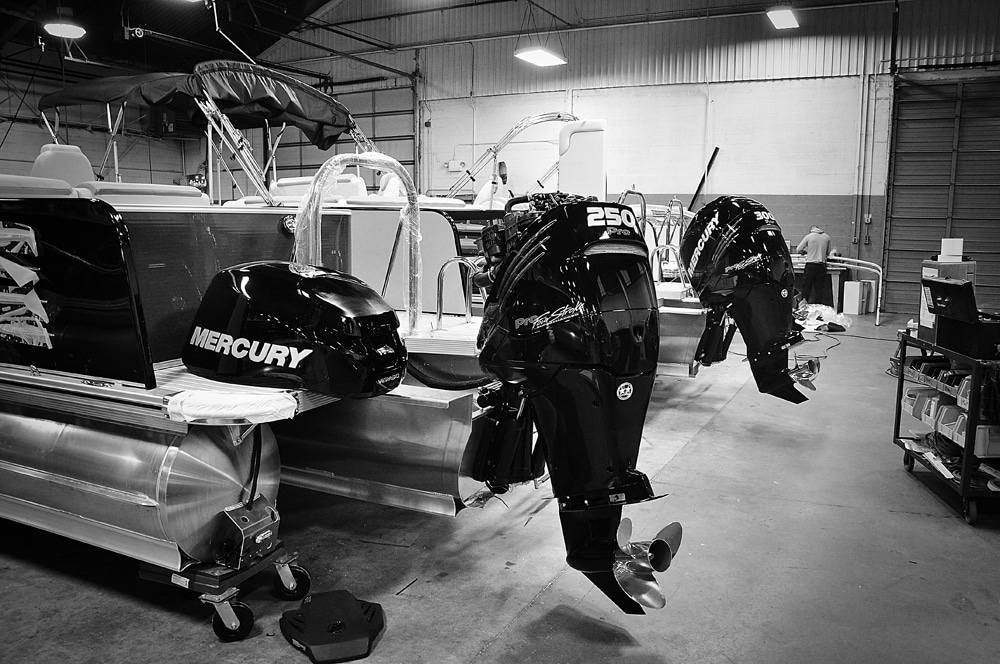
Choosing the Right Pontoon Boat Engine
Pontoon boat size and power requirements are growing as fast as the presence of these watercraft on waters all over the world. Offered in lengths from under 15 feet to more than 30 in length overall, with double- and triple-tube configurations, pontoon boats are currently “hot” with boaters. To find out what you should look for when buying one with outboard power — or repowering your existing pontoon — we convinced some outboard industry experts to share the “hull truth” about powering pontoons.
What Size Motor for a Pontoon Boat?
What makes powering pontoon boats special? The fact is that powering every boat type has its subtleties. Part of the equation is how different types of boats are generally used. Another component is the design of the boat being powered. For instance, a pontoon boat has a vastly different physical configuration than a runabout’s configuration.
“With a monohull, you have deadrise and strakes and chines to help the boat get up on plane and carve the water and hold an edge,” explains Jim Hergert, the Mercury Marine category manager. “With a pontoon, you basically have two or three rounded surfaces to work with, so you have to rely more on the motor to get the boat on top of the water, and to point and direct the boat,” Hergert says, adding, “On a pontoon, the engine is doing more of the work than when matched with a monohull. Selecting and properly installing an outboard for a pontoon is even more critical than for traditional boats.”
Of course, many pontoons are available with specially designed tubes featuring flatter sections. Many also have tubes with running strakes. Features like these provide lift, so just how much performance is engine-dependent versus boat-dependent varies with the specific boat. But Hergert’s wisdom stands: One cannot treat pontoon power as a commodity.
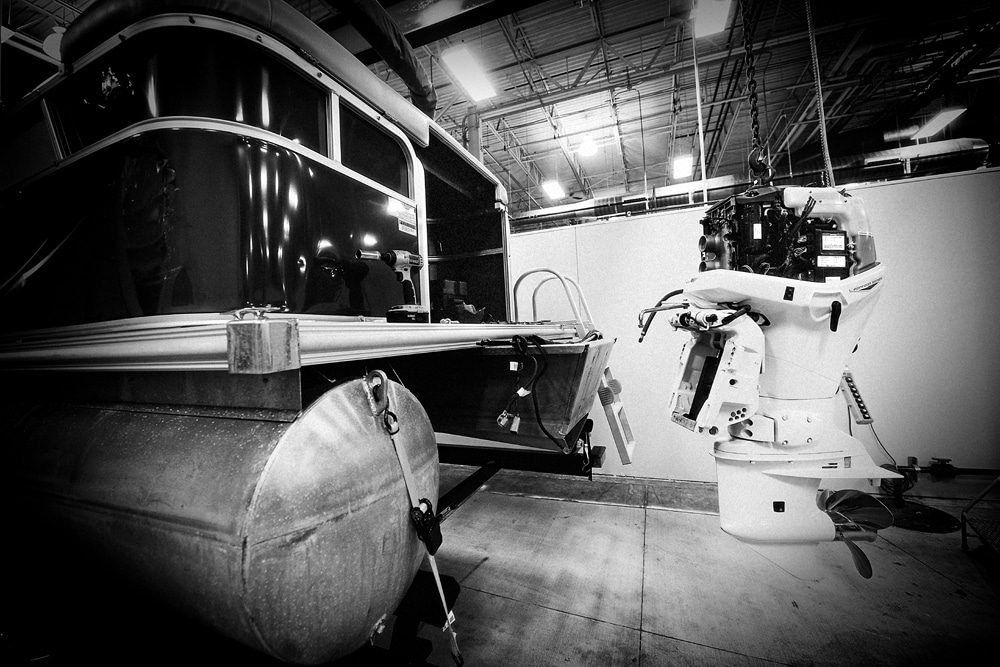
Choosing the Right Pontoon Boat Engine
To determine the right size motor for your particular pontoon, Evinrude’s Jason Eckman stresses the importance of matching the horsepower with the anticipated load and activity that the boater expects to enjoy aboard his or her pontoon. “Many customers will trade up after only one year because they usually underestimate how much horsepower they need. It’s vital for consumers to communicate with a dealer on how they plan on using the boat before making a purchase.”
What type of information, exactly, should you communicate? Tell the dealer how many people you expect to bring on board. Inform the dealer if you intend to pull wakeboarders or water skiers. The dealer probably knows the local waters where you’ll be using the boat, but perhaps you don’t intend on using the boat locally. Make locale part of the discussion, since you may require more power on a river or on the coast than you do on a lake or impoundment. Good dealers will walk you through this process, and often, the “upsell” with higher-horsepower pontoon boat motor recommendations is often sound advice. But all of this starts with you honestly self-assessing your boating needs.
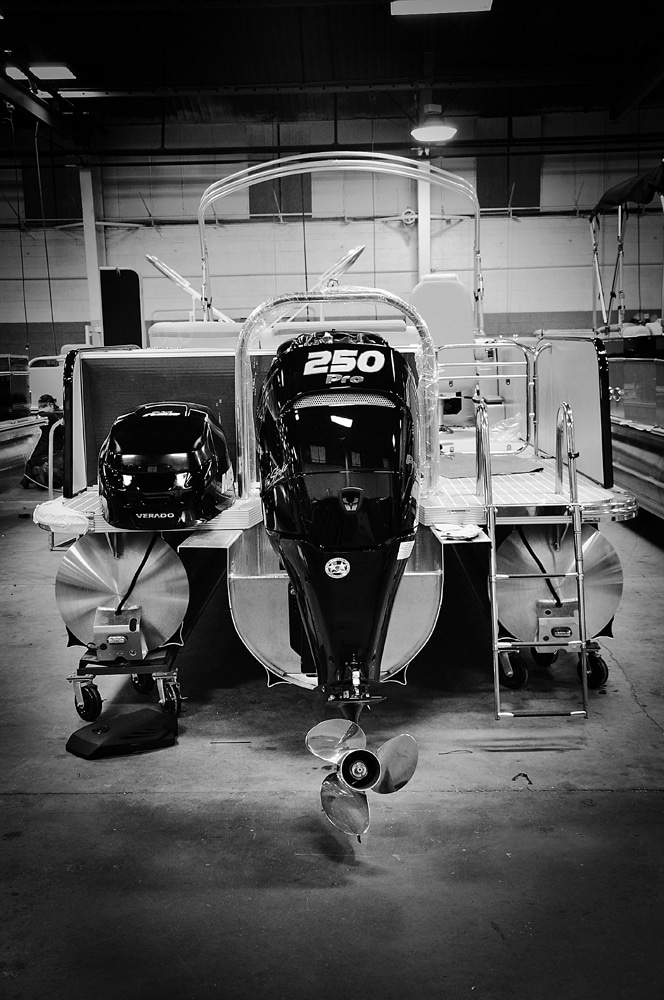
Choosing the Right Pontoon Boat Engine
How to Install an Outboard Motor on a Pontoon Boat
So, with the help of a knowledgeable dealer, you’ve selected the right power option for you. Even with the “perfect” engine, your ownership experience can still be spoiled if the installation isn’t done properly. What are some of the issues that you can check on and ask your dealer about? Let’s start with the physical mounting of the engine.
“As with any boat, engine mounting height on pontoons is critical,” says Merc’s Hergert. “To find the sweet spot, you want to make sure you have the anti-ventilation plate below the waterline so there’s no prop ventilation, but not so deep as to allow the gear case to create excessive drag. And you need to test that height setting with passengers or loads where they will be located when the boat is in use.”
For example, a pair of anglers seated on bow pedestals can force the stern up enough to create (prop) ventilation at low speed. If you plan to fish a lot with people in those positions, that will affect how low you want to mount the outboard on the transom.
This is a powering quirk almost exclusive to pontoon boats, and this relates not only to how you use the boat but also to the boat’s layout and how many people you take out (crew seated forward would be balanced by crew seated aft, for instance). We’ll reveal more from the pros on this bow-weighting phenomenon a few paragraphs further on.
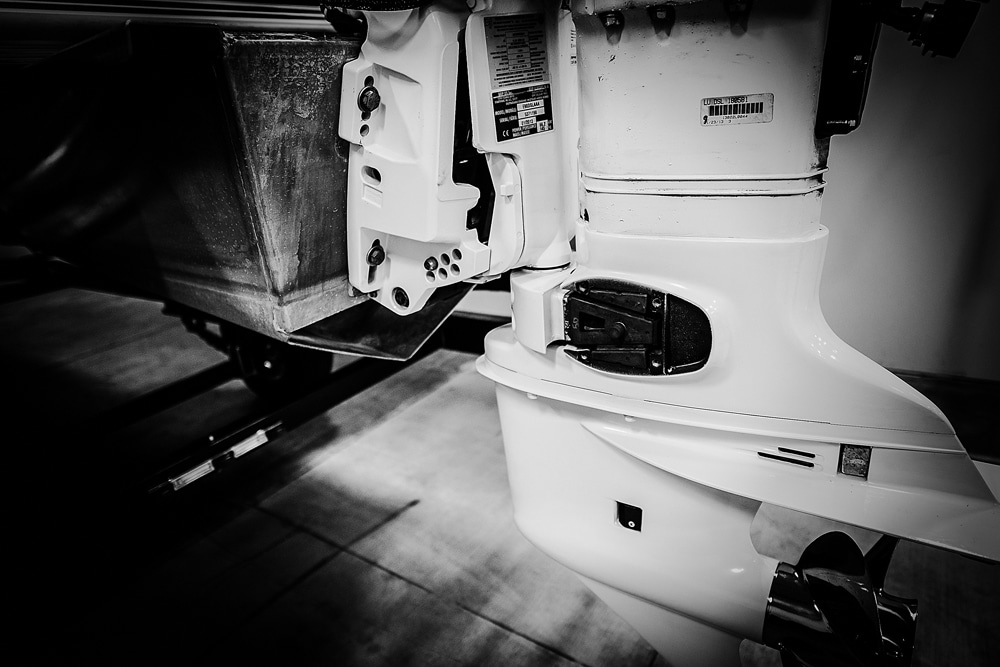
Choosing the Right Pontoon Boat Engine
Choosing the Right Pontoon Boat Engine Propeller
Choosing the propeller is no less critical than getting the mounting height right. Of course, you are limited to some degree by the gear case size and gear ratio, but there is still a lot of know-how that goes into properly propping a boat. The pros say that selecting the correct propeller is especially critical for pontoon boats. When you are considering a traditional “two-log” pontoon boat, the choice is completely different from that for a similarly sized V-hull boat.
“Because the engine plays a bigger role in the handling of a pontoon boat, identifying the right prop is even more important than it is for mono-hull boats,” claims Mercury Marine product application engineer Tony Cody. “Because you’re often not as concerned about top end as you are with thrust and low-range handling with a pontoon and the ventilation issues with twin-tube pontoons, you want to swing the most blade surface possible. That’s why big-diameter, four-blade props are usually better for pontoon applications.”
The intricacies of propeller selection range into ever-deeper subtleties as you start to consider “performance” pontoons — those with three tubes and underwater shapes optimized for increased lift.
Evinrude’s Eckman says, “Propeller choice is even more crucial for powering tri-toons. The center pontoon actually provides clean water for the prop to help it stay connected to the water, so little differences in prop design can have a bigger impact on performance when compared with regular pontoons.”
“Engine trimming plays a smaller role on a pontoon since you’re not using the engine for leverage to try to lift the bow, like you do with a mono hull,” Cody says. “However, with a tri-toon, the log in the center allows a pontoon to act almost like a V-hull, so engine trim does come more into play to help balance the boat.”
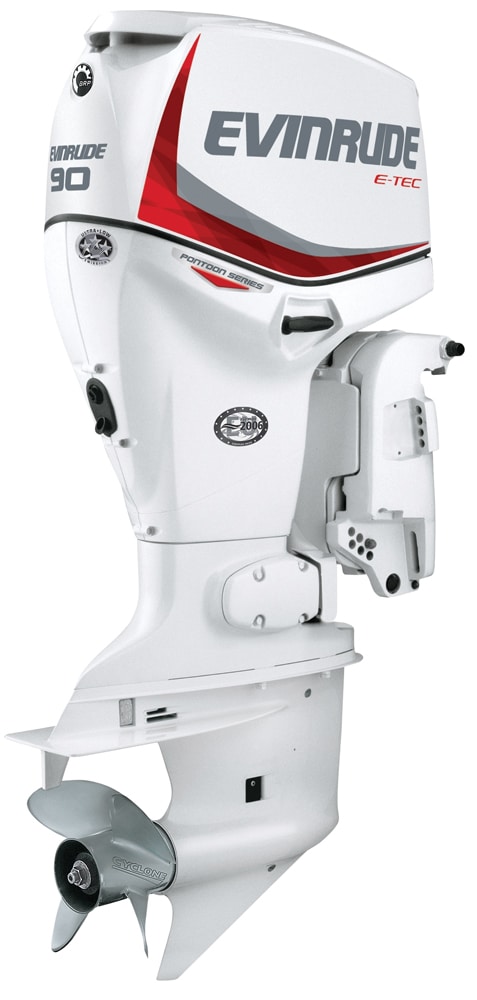
Engine builders have packaged motors with many pontoon-compatible traits to help you make a better selection. Evinrude has a Pontoon Series of E-TEC outboards, offering a gear ratio that improves low-end thrust, a software file to enhance engine performance at idle and low speeds, and specially designed motor mounts to reduce vibration. Mercury Bigfoot outboards come in 40 hp and 60 hp ratings. They feature a deep 2.33:1 gear ratio and a larger gear case — the same size as that on a 115 outboard. The taller gear case can help ensure the prop is kept in the water and also allows installation of larger-diameter propellers for better thrust.
A common complaint Cody hears from owners of twin-tube pontoon boats concerns trim that shifts when passengers are seated forward, causing ventilation while running at speed or during turns. “That can be addressed by running a prop with a larger diameter and more cup to grab more water.”
The point is that you can ask your dealer up front what prop comes with the boat and what characteristics it is intended to deliver. If you are that pontoon boater who’ll be at the wheel while three family members sit forward, maybe you’ll need a prop with a larger diameter or more cup. You need to ask the question.
Sterndrive Engines for Pontoon Boats
Outboards are the popular choice for pontoons, but sterndrives are a power option on some larger models. “Pontoons are built with aluminum frames and trim, and composite or wood decks, so you do get more vibration resonating through the boat than you would with a fiberglass monohull,” explains Hergert. “When you place a sterndrive into a compartment that is welded to the boat’s frame, you need to have really good mounts to isolate the vibration within that compartment. It’s not nearly as big of an issue with an outboard hanging off the transom, but when you’re dealing with a sterndrive application aboard a pontoon, addressing vibration is key.”
When it comes to pushing pontoons, power rules. Make sure you are armed with enough information to ask your dealer the right questions when selecting pontoon boat power.









